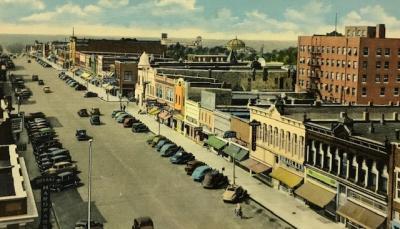Community Development Division
118 W. Central Ave.
Arkansas City, KS 67005
(620) 441-4420
Downtown Historic District
The City of Arkansas City was founded in 1870 and incorporated as a city in Cowley County the following year.
The population of the City was 214 in 1870, when Osage tribal land was opened for settlement that July. By 1880, it had swollen to 1,799, according to Cutler’s History of Kansas.
The first building in the settlement was a log house. A general store from Emporia and a newspaper, first published in August 1870, quickly followed.
C.M. Scott, publisher of The Arkansas City Traveler, noted there were 12 houses and 38 business buildings in the new town site.
With the news of the pending arrival of the Atchison, Topeka & Santa Fe rail line, the town constructed a water sawmill and flour mill.
By 1881, the town had its own waterworks, with spring water pumped to a reservoir in the southern portion of the city.
Arkansas City improved its downtown commercial district rapidly in the 1880s, building several handsome brick-and-stone buildings on South Summit Street between Adams and Fifth avenues.
Business growth also occurred along Central Avenue.
Between 1910 and 1930, the town continued to boom with the discovery of oil in Cowley County, and the first refinery was constructed in 1917. A second refinery was built in 1923. The economy of the town took off as the flour mills and the meat package industry grew.
The oil boom, which reached its peak in 1925, tapered off in the late 1920s and 1930s, but the population remained relatively stable (around 12,000 to 14,000) through World War II, supported by trade and other industries.
Just prior to World War II, the cities of Arkansas City and Winfield arranged for the joint purchase of land for construction of an airport, now known as Strother Field.
During the war, the U.S. Army Air Corps leased the land and developed the field as a training base.
The military returned Strother Field to the cities a short time later.
Between 1960 and 1990, Arkansas City experienced a gradual loss of population, from a high of 14,262 in 1960 to 13,201 in 1980.
The downtown remained the primary location for finance and specialty retail shops for years, keying a regional retail hub, but a primary concern of community leaders at the time was the renovation of older downtown buildings, which continues to be a local challenge to this day.
The 1990s and early 2000s presented serious economic losses to the community when Morrell Meats and the Total Petroleum refinery closed.
New businesses have moved in, and others have expanded, including Creekstone Farms Premium Beef, which now employs more than 1,000 people.
You can learn more about many of the buildings by clicking on the left hand menus. To participate in a walking tour you have several options. The printed brochures will be available at the Visit Ark City offices at 106 S Summit Street or an electronic version is linked below. Finally, you can access a specially designed web application that will walk you through the walking tour on your mobile device. Links will be provided for you to learn more information about each building. The web app can be accessed by visiting https://arcg.is/1GXS9H

